Analysis of which researchers publish, get credit, move around, get funding, collaborate and receive citations shows how deeply ingrained the bias against women is.
Equity for Women in Science: Dismantling Systemic Barriers to Advancement Cassidy R. Sugimoto and Vincent Larivière Harvard Univ. Press (2023)
Are gender inequities slowly disappearing in the natural and social sciences? Those who argue so might point, say, to election to prestigious academies, such as the US National Academy of Sciences and the American Academy of Arts and Sciences. Until the 2000s, women were under-represented, but in the past 20 years, women have been advantaged relative to similarly credentialed men in psychology, economics and mathematics. Equity for Women in Science is a convincing reply to those who advance such arguments. Less overt — all but invisible — gender gaps are still with us.
Every scientist experiences advantages and disadvantages, acceptances and rejections, citations and a lack thereof. In most societies men are advantaged relative to women, but at the individual level, advantage varies and is subject to multiple influences, including skin colour and socioeconomic status. The combined subtlety and variability of privilege make it difficult to observe and document the aggregate imbalances. That requires sophisticated and ingenious efforts.
Cassidy Sugimoto and Vincent Larivière, information scientists at the Georgia Institute of Technology in Atlanta and the University of Montreal in Canada respectively, have the sophistication and ingenuity, and have put in the effort. Their book summarizes scientometric and bibliometric analyses, conducted by themselves and their colleagues, of the influence of gender on outcomes in academia. The analyses show who publishes, who gets credit, who gets funding, who has job mobility, who collaborates and whose work is cited.
Big data
The book isn’t all numbers. Besides copious amounts of data, the book provides revealing vignettes of the experiences of women in science, along with telling examples of institutional practices, both past and present. Nature, for instance, used the phrase ‘men of science’ in its mission statement until the year 2000, and did not have a female editor-in-chief until 2018. My favourite example, also from 2018, concerns Donna Strickland, physicist at the University of Waterloo in Canada, who received a share of the Nobel prize in physics that year for her work on short-pulsed lasers. At the time, she was an associate professor whose Wikipedia entry had just been rejected on the grounds that she didn’t meet the online encyclopedia’s notability criteria.
But the numbers do speak volumes. Sugimoto and Larivière’s global analyses show that although gender inequity occurs everywhere, there are interesting differences by country. For example, the proportion of female authors on papers varies, even among economically advantaged countries. Japan has lower rates than China (17% vs 26%), whereas China and Germany show similar rates. They are all lower than the world average of 31%.

Donna Strickland’s Wikipedia page was initially rejected despite her later winning the Nobel prize.
Credit: Jonathan Nackstrand/AFP/Getty
Some of Sugimoto and Larivière’s analyses are straightforward data mining, such as those documenting the common observation that female researchers, on average, publish less than male researchers do. (Non-binary status cannot be detected from their byline analysis). Without controls, on average, women published 20% fewer papers than men (4 vs 3.2 overall) between 2008 and 2020. That difference was reduced to 7% (4.2 vs 3.9), however, when the productivity analysis was restricted to a group of (presumably younger) researchers who published their first article in 2008. Younger people published more, with women increasing their production more than men. It is hard to pinpoint the driver for this, given the breadth of societal changes in the past two decades. Bibliometric analyses can reveal only so much: the trend might be explained by there being more women in almost every field now, more attention being given to gender gaps, more efforts to support women in science, more hiring of women at research institutions, or some combination of those and other factors.
But why does the gap in paper publication exist in the first place? The authors investigated the role of parenting, using data from an as-yet unpublished paper. It involved an international survey sent out to 1.5 million potential participants. Of these, 10,400 (fewer than 1%) yielded usable data. The representativeness of that sample is unclear, but the conclusions make sense. The authors found that the extent to which being a parent affected productivity depended more on how much time someone spent actively parenting than on how many children they had: if you leave the active parenting to someone else, it doesn’t matter whether you have one child or five. According to various studies, women are on average more engaged in parenting than are men, especially “invisible” parenting — being on call, planning, monitoring children’s emotional well-being and so on.
Sugimoto and Larivière address issues — collaborations, mobility, funding — that contribute to women’s disadvantages relative to men’s. A recent study in Nature demonstrated a deeper problem: women who appeared in progress reports for physics grants as doing equal work to men were nevertheless less likely to appear as authors on papers emanating from those grants (M. B. Ross et al. Nature 608, 135–145; 2022). The more important the paper, the less likely women were to be included. Data from fields such as economics also suggest that women’s contributions are undervalued compared with men’s, even when they publish equally well in high-impact journals.
Quality and equality
Perhaps the most important chapter of the book investigates disparities in citation rates. As the authors point out, ideas cannot change a field if people do not pay attention to them. Men are cited more than women are. People who believe that the present system is largely meritocratic would see citations as a reasonable proxy of an article’s quality and importance. Does that mean that women just do lower-quality work?
Sugimoto and Larivière break things down by a journal’s impact factor to address this possibility. (The impact factor is the average number of times that articles published in a journal are cited.) Papers with men as first authors have at most a tiny citation advantage over those with female first authors for publications with impact factors of 1 or below. As impact factor increases, so do both the number of citations and the disparity. The average number of citations jumps from 2, for journals with an impact factor of 1.75–2, to 4 when the factor is above 2. At that impact factor, men have 0.5 citations more than women on average, compared with 0.1 below that factor. Women simply do not reap the same rewards as men.
More interpretation of the importance of the citation disparity — and the other disparities documented in the research — would have been welcome. A sceptic might note, for example, that although women publishing in high-impact journals are cited considerably less frequently than men publishing in the same journals, they are still cited much more often than men or women in journals with lower-impact factors. Sugimoto and Larivière briefly bring in the concept of the accumulation of (dis)advantage — how small advantages and disadvantages compound over time to produce notable effects — but they could have spelled out its applicability at greater length and shown its effects. The original insight that advantage compounds over time — similar to compound interest on an investment or debt — was from the sociologists Robert Merton and Harriet Zuckerman. They in turn cite a considerably older, biblical source:Matthew 25:29, “to every one who has, more will be given”. Computer simulations show that small consistent differences in treatment add up to substantial changes in career trajectories.
Equity for Women in Science is primarily a compendium of the authors’ compelling research. It is weakest in its contextualization of that research. Since their work consists mainly of non-experimental analyses of large-scale patterns in publication, funding and migration between institutions, it does not directly address the underlying mechanisms. The book sparsely and selectively samples the large literature on the socio-psychological, organizational and institutional mechanisms that contribute to gender disparities, and interventions that can address them effectively.
Similarly, the authors do not tie together how they think the different components of the scientific enterprise interact. They eschew a large model that would show how, for example, funding and collaboration interact to affect academic careers. For readers with their own theories, the rich array of data could provide a testing ground even if it does not provide new insights. For those who want to challenge their beliefs in science as agender-fair enterprise, the data amply serve that purpose.
Nature 619, 244-246 (2023)
doi: https://doi.org/10.1038/d41586-023-02139-x



Recommended Comments
There are no comments to display.
Join the conversation
You can post now and register later. If you have an account, sign in now to post with your account.
Note: Your post will require moderator approval before it will be visible.